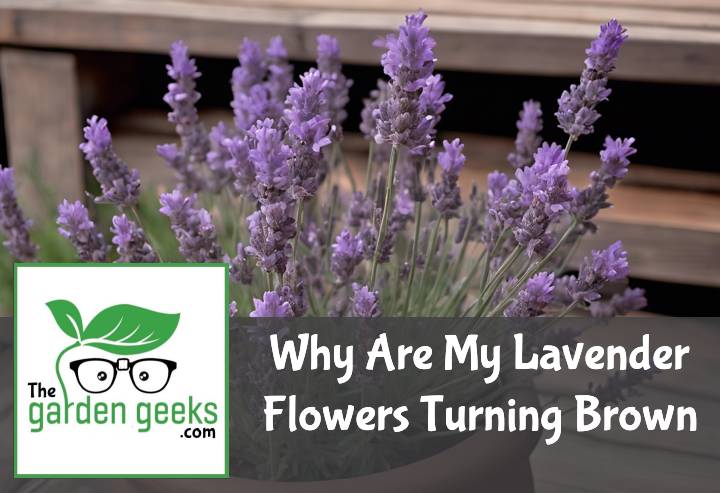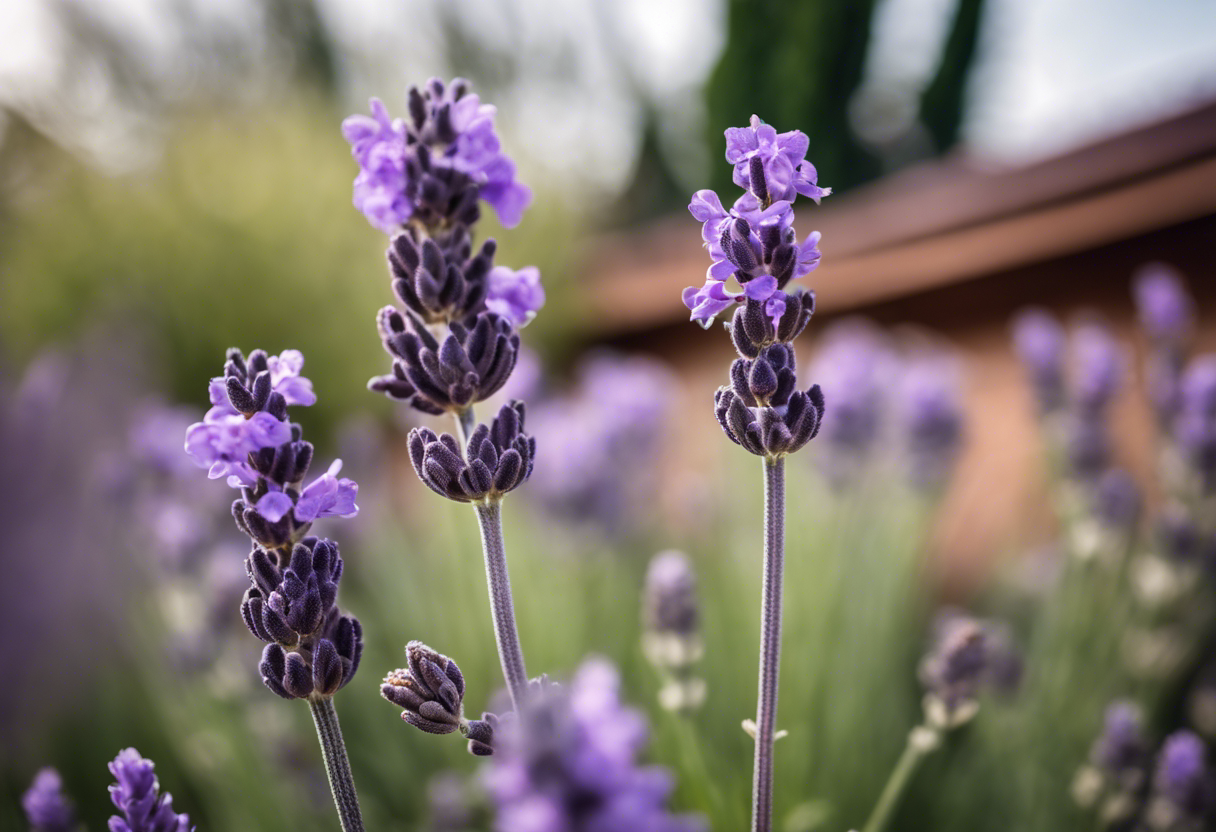Ever looked at your lavender plant and thought, Why Are My Lavender Flowers Turning Brown? If you’re nodding along, then my friend, you’re not alone. I’ve been down that road too – staring at my once vibrant lavenders now sporting a rather unflattering shade of brown.
But don’t worry! We’ll unravel this mystery together. And by the end of this post, we’ll have not one but three solutions to bring back the purple glory to your garden. So buckle up and keep reading about ‘Why Are My Lavender Flowers Turning Brown? (3 Solutions)’.
Key Takeaways
- Lavender flowers may turn brown due to overwatering, poor soil drainage, or fungal diseases.
- Overwatering can cause root rot, leading to browning. Water lavender only when the top inch of soil is dry.
- Poorly draining soil can also lead to root rot. Plant lavender in well-draining soil or raised beds.
- Fungal diseases like shab disease and Phytophthora root rot cause browning. Treat with appropriate fungicides and ensure good air circulation around plants.
Understanding Lavender Plant Health
When it comes to lavender plant health, a little TLC goes a long way. You see, lavenders aren’t just pretty faces in the garden; they’re tough cookies too. But even the toughest of plants need some love and care.
The Importance of Proper Care for Lavender Plants
Now, you might be wondering, why all this fuss about caring for lavender plants? Well, proper care is like the secret sauce for healthy lavender growth. It’s what keeps your lavender blooming season after season, filling your garden with that intoxicating aroma we all know and love.
And when it comes to essential lavender maintenance, it’s not rocket science. A bit of sunshine here, some well-drained soil there, and voila! You’ve got yourself a happy lavender plant.
But remember folks, even though lavenders are pretty low-maintenance, they still need that optimal lavender care to thrive. So don’t skimp on the TLC!
Recognizing Signs of Distress in Lavender Plants
Now let’s talk about those times when your lavender starts acting up. Yes, I’m talking about those dreaded signs of distressed lavenders. One day you’re admiring your beautiful blooms, and the next you’re asking yourself “Why Are My Lavender Flowers Turning Brown?”
Well folks, brown flowers are one classic sign that your lavender is crying out for help. Other signs could include wilting leaves or stunted growth – basically anything out of the ordinary.
And as for what causes these distress signals? It could be anything from overwatering to poor soil conditions or even pests. Identifying sick lavenders early can save them from further damage.
So keep an eye out for any changes in your lavenders’ appearance or behavior. Remember – a healthy lavender is a happy lavender!
Why Are My Lavender Flowers Turning Brown?
If you’re asking, “Why Are My Lavender Flowers Turning Brown?”, don’t fret. It’s a common question among lavender enthusiasts. The usual suspects are water-related issues and pest or disease infestations. Let’s dive into these lavender plant problems.
Lack of Water and Its Effects on Lavender Flowers
Under-watering your lavender can lead to those dreaded brown lavender flowers. When lavenders don’t get enough water, they start to wilt and brown out. This is one of the most common effects of drought on lavender.
The signs of under-watering include droopy leaves and dry soil. If you notice these symptoms, it might be time to give your plant a good soak. But remember, balance is key when watering lavender plants.
Overwatering and Root Rot in Lavender Plants
On the flip side, overwatering can also cause havoc for your lavenders. Too much water leads to root rot, which in turn causes those brown blooms we all dread seeing.
Symptoms of overwatered lavenders include yellow leaves and a musty smell from the soil. If you suspect root rot, cut back on watering immediately.
Preventing root rot in lavenders isn’t rocket science. Just ensure proper drainage and avoid soggy conditions – your lavenders will thank you!
Impact of Pests and Diseases on Lavender Flowers
Finally, let’s talk about pests and diseases – the bane of any gardener’s existence! They too can be responsible for turning your beautiful purple blooms brown.
Common culprits include aphids, whiteflies, and fungal diseases like Botrytis cinerea (gray mold). These pests suck the life out of your plant while diseases attack its immune system causing browning.
Identifying these pests or diseases early is crucial for effective treatment. Look for signs like discolored leaves, moldy spots, or tiny bugs on the plant. Then, treat with appropriate pesticides or fungicides.
Remember, a healthy lavender is a happy lavender! So keep an eye out for these issues and your lavenders will be back to their vibrant purple selves in no time.
Solution 1: Proper Watering Techniques for Healthy Lavenders
Alright, let’s dive into our first solution. Why Are My Lavender Flowers Turning Brown? It could be all about the water! Lavenders are a bit picky when it comes to their hydration needs. So, mastering proper watering techniques is key to keeping your lavenders happy and healthy.
Identifying the Right Amount of Water for Your Lavenders
So how much water do these purple beauties need? Well, it depends on a couple of things. First off, your local climate plays a big role in determining lavender water requirements. If you’re living in a desert-like area, your lavender might need more frequent watering compared to those residing in cooler climates.
Next up is soil type. Sandy soils drain faster than clay ones, meaning they’ll require more frequent watering. On the other hand, if you’ve got heavy clay soil that retains water well, you might risk overwatering lavenders. The trick here is to keep an eye on your plant and adjust as needed.
Implementing a Consistent Watering Schedule
Now that we’ve figured out how much water our lavenders need, let’s talk about when they need it. Establishing a regular watering routine can work wonders for preventing those dreaded brown flowers.
Consistency is key here folks! A regular lavender watering schedule, say once or twice a week depending on weather conditions and soil type can help keep those flowers vibrant and healthy. Remember though, overdoing it can lead to root rot and underdoing it can cause dehydration – both culprits of browning flowers.
So there you have it – proper hydration could be the answer to your question: “Why Are My Lavender Flowers Turning Brown?” Keep an eye on those lavenders and adjust as needed – they’ll thank you with their beautiful blooms!
Solution 2: Pest and Disease Control for Lavenders
When you’re scratching your head, wondering, “Why Are My Lavender Flowers Turning Brown?”, it might be time to consider pest and disease control. Maintaining healthy lavenders isn’t just about watering and sunlight; it’s also about keeping those pesky bugs at bay and treating diseases promptly.
Common Pests that Affect Lavenders and How to Deal with Them
Ever noticed tiny green critters on your lavender? Those are probably aphids on lavenders, a common pest that can cause damage. Don’t panic though! There are organic pest control methods available to help you out.
Another common nuisance is the whitefly. If you spot these whiteflies in lavender plants, it’s crucial to act quickly. They can cause leaf yellowing and even lead to plant death if left unchecked.
And let’s not forget about spider mites. Dealing with these little guys can be tricky, but with the right approach, effective lavender pest management is totally doable.
Recognizing and Treating Diseases in Your Lavender Plants
So, what if pests aren’t the problem? Well, diseases could be causing your lavender flowers to turn brown. Recognizing the signs of diseased lavenders early can save your plants from irreversible damage.
Fungal diseases are pretty common in lavenders. If you notice a powdery substance on leaves or stems, that could be a sign of fungal infection. But don’t worry – there are ways of treating fungal diseases in lavenders effectively.
Root rot is another culprit that might be messing with your lavender’s health. It’s usually caused by overwatering or poor drainage conditions. So keep an eye out for any signs of root rot in lavender plants.
Lastly, bacterial diseases can also affect your lavenders negatively. But fear not, with proper care and attention, managing bacterial diseases in lavenders is possible. And remember, prevention is always better than cure when it comes to maintaining a healthy lavender garden.
Solution 3: Optimal Soil Conditions for Growing Healthy Lavenders
The soil can make or break your lavender’s health. It’s like the bed where your lavender sleeps, and we all know how important a good night’s sleep is, right? So, let’s dive into the world of soil conditions for lavenders and learn how to provide the best environment for healthy lavender growth.
Understanding the Ideal Soil Type for Growing Lavenders
Lavender plants are quite picky when it comes to their bedding. They prefer well-drained, sandy or gravelly soils with a neutral to slightly alkaline pH. This type of soil mimics their natural Mediterranean habitat.
Now you might be wondering, “why lavenders need specific soils?” Well, this ideal soil for lavenders allows them to grow strong roots and absorb nutrients effectively. It also helps in preventing lavender diseases.
Ensuring Proper Drainage to Prevent Root Rot
Root rot is like a nightmare that haunts many gardeners. And guess what? Your lavender plants fear it too! But here’s some good news – proper drainage can keep this horror story at bay.
The key to preventing lavender root rot is ensuring your soil doesn’t hold onto water like a sponge. Instead, it should drain quickly while still retaining enough moisture for the plant’s needs.
If you’re thinking about “how to ensure proper drainage in lavender plants“, consider adding organic matter or sand to heavy soils. This will improve drainage and prevent waterlogging – saving your precious lavenders from turning brown!
To Wrap Up
So, we’ve been on a bit of a rollercoaster ride with our lavender plants, haven’t we? From understanding the reasons behind their brownish makeover to figuring out how to nurse them back to health. It’s like playing Sherlock Holmes but in your garden!
Remember, Why Are My Lavender Flowers Turning Brown? is not just a question, it’s an adventure! So put on your gardening gloves and let’s turn those brown frowns upside down!





